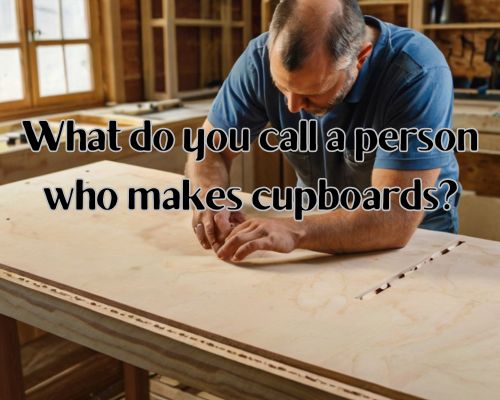What do you call a person who makes cupboards? Understanding the Cabinetmaker’s Role
What do you call a person who makes cupboards? Understanding the Cabinetmaker’s Role
In the world of woodworking and carpentry, precise terminology helps in understanding the roles and skills involved.
When it comes to someone who makes cupboards, the term you’re looking for is typically ‘cabinet maker’.
Cabinet makers use their expertise to craft custom cupboards and various types of cabinetry. They work with materials like wood, metal, or sometimes plastic.

This role is distinct yet closely related to that of a carpenter, with a strong focus on precision in creating functional and aesthetic storage solutions.
Your interest in cupboard craftsmanship may lead you to explore other furniture-making aspects.
The skills of a cabinet maker extend beyond just cupboards. They also design and install cabinetry for kitchens, bathrooms, and other spaces in homes or businesses. This makes them vital contributors to interior design and functionality.
Whether it’s selecting the perfect grain of wood or implementing cutting-edge finishes, cabinet makers combine artistry with technical skill.
Understanding the nuances between cabinet makers and broader carpentry can enrich your appreciation for the craft.
While carpenters might build structures like frameworks and roof trusses, cabinet makers delve into intricate details and fine furnishings, see https://morningtoncabinetmakers.com.au/.
This distinction helps highlight the unique skill set involved in cupboard making and similar woodworking tasks.
If you’re fascinated by how your kitchen cabinets or living room bookshelves come together, you’re about to discover the craftsmanship involved.
Professionals in Cupboard Creation
When seeking expertise in cupboard creation, you’ll encounter a range of skilled professionals, each specialising in various aspects of woodworking.
Cabinet Makers and Their Skills
Cabinet makers are highly skilled craftsmen specialised in designing and constructing custom cabinets. They work with an array of materials, including wood, metal, and plastic, to create custom designs.
Their work often involves intricate detail and precision to ensure that each piece meets specific requirements.
Cabinet makers not only build freestanding pieces but also integrate built-in cabinetry into spaces like kitchens and bathrooms.
Their expertise lies in creating pieces that complement a room’s aesthetics while providing practical storage solutions.
Cabinet making demands a keen eye for detail and an understanding of various finishes and techniques.
Skills in joinery, woodworking, and the use of specialised tools are essential.
This profession requires both creativity and technical prowess, enabling cabinet makers to transform raw materials into fine furniture masterpieces.
Carpenters and Joiners
Carpenters and joiners are often involved in broader construction and woodworking projects.
Carpenters typically handle a wide range of tasks, from framing buildings to installing woodwork. They are versatile professionals who work on both structural and finishing elements of construction projects.
Joiners, however, are more focused on constructing the joints and elements that make up fine furniture and cabinetry.
This includes crafting and fitting the parts that go into creating cupboards and other wood pieces.
While their work might overlap with that of cabinet makers, joiners specialise in the precision and strength of connections between wooden components.
Both carpenters and joiners bring a wealth of experience to the creation of durable and aesthetically pleasing cupboards, see https://morningtoncabinetmakers.com.au/.
Their skills are essential in ensuring that furniture is not only functional but also seamlessly integrated into the overall design of a space.
Distinguishing Between Woodworking Roles
Understanding the differences between these professionals is important when considering your cupboard needs.
Cabinet makers are best suited for detailed, custom projects requiring high levels of artistry and craftsmanship.
They excel at creating pieces with intricate designs and fine finishes, ideal for unique, bespoke projects.
Carpenters, with their broader skill set, are perfect for projects that require structural integrity and general woodworking skills.
They are adaptable and can work on a variety of construction and repair tasks beyond just cabinetry.
Joiners focus specifically on the assembly and detailing of fine joinery work.
Their ability to create strong, precise joints makes them invaluable for projects that require detailed finishes and high-quality construction.
Types and Uses of Cupboards
Cupboards serve a range of functions, from organising kitchen essentials to storing clothing in wardrobes. Different types are designed for specific rooms and needs, ensuring that every space is utilised efficiently.
Kitchen and Laundry Cabinets
In the kitchen, cupboards are essential.
Base cabinets form the foundation, providing storage for heavier items like pots and pans.
The overhead variants offer space for crockery and other everyday essentials. These are usually built with adjustable shelves and are made using durable materials, like wood or metal.
In the laundry, similar cupboards are used to store detergents, cleaning supplies, and sometimes even clothing that needs airing or ironing.
Wardrobes and Closets
Wardrobes are designed to store clothing and accessories, ensuring easy access and organisation.
Built-in wardrobes in modern homes often include hanging rods, drawers, and shelves. Some designs have mirrored doors, which add functionality and visual space.
An armoire is a standalone piece, often more ornate, used to store additional clothing or even linens.
A closet performs a similar function but can range from small, simple designs to larger walk-in spaces.
Specialised Storage Solutions
For specific storage needs, specialised cupboards come into play.
A stationery cupboard is ideal for keeping office supplies organised and accessible.
Designed for homes or workplaces, these cupboards help manage items like paper, pens, and folders.
Built-ins can also cater to unique storage needs. Media cabinets are perfect for electronics, while constructed spaces are great for collectibles and hobbies.
This ensures that your space remains clutter-free and each belonging has a designated place.